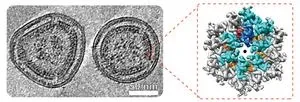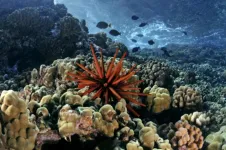Ancient reef-builders dodged extinction — at least temporarily
Study shows that ancient reef-building stromatoporoids survived the Late Devonian extinction and continued to thrive during the Carboniferous Period
2024-09-25
(Press-News.org)
Will modern coral reefs go extinct? The answer is uncertain, but some of their ancient counterparts managed to dodge a bullet — for a while, at least.
Scientists from Osaka Metropolitan University have discovered that ancient reef-building organisms called stromatoporoids survived the Late Devonian mass extinction event and continued to thrive as major reef-builders long after their presumed extinction. These findings shed light on how life on Earth has responded to past environmental changes, offering valuable insights into the resilience and adaptability of marine ecosystems.
Corals are the most well-known reef-builders today, but reefs have been built by a variety of organisms throughout Earth history. One such group was the stromatoporoids, sponge-like organisms that played a major role in reef-building during the Paleozoic, particularly in the Silurian and Devonian periods (roughly 444 to 359 million years ago).
“Stromatoporoids were thought to have vanished as reef-builders after the Late Devonian extinction,” said Yoichi Ezaki, a professor at Osaka Metropolitan University’s Graduate School of Science and lead author of the study.
The Late Devonian extinction was one of five mass extinction events in Earth history. It significantly affected marine life, causing a decline in the diversity of reef-building organisms. During the Carboniferous (roughly 359 to 299 million years ago), which followed this devastating event, no stromatoporoid reef was known to exist…until now.
Scrutinizing fossils from Carboniferous rocks found in the Akiyoshi Limestone Group of southwest Japan, the research team discovered laminated skeletons with laminae, or layered, and pillar-like structures — typical features of stromatoporoids.
“Contrary to previous beliefs, our findings in Japan show stromatoporoids not only survived but continued to be instrumental in reef construction during the Carboniferous,” said Ezaki. “We feel sure this discovery will rewrite the content of textbooks.”
The Akiyoshi Limestone formed on a seamount in the Panthalassa Ocean through the Mississippian (early Carboniferous) to middle Permian periods. Stromatoporoids, alongside the organism Chaetetes, thrived on the warm shallow-water seamounts of the Panthalassa Ocean, benefiting from conditions such as enhanced ocean circulation, upwelling, and nutrient supply, culminating in elevated carbonate saturation due to ongoing global glaciation.
This suggests that isolated and unique oceanic environments like Akiyoshi may have allowed the survival of these resilient organisms.
“The isolated Akiyoshi seamount might have harbored a unique biological community, potentially forming a ‘Carboniferous Galápagos’ that offers a glimpse into the complex dynamics of ancient marine ecosystems,” said Ezaki.
Intensified global cooling and exposure above sea level eventually took their toll on the stromatoporoids. Still, the continued presence of these reef-building organisms in the late Carboniferous suggests that they adapted to new ecological niches in response to the changing climate.
The study’s findings highlight the potential resilience of certain reef-building organisms in distinctive environments, providing valuable lessons for today’s conservation efforts.
“Understanding how stromatoporoids and other organisms adapted to survive past climatic and environmental upheavals offers crucial insights into how modern reef ecosystems might handle current and future climate changes,” said Ezaki.
The study was published in Geology.
###
About OMU
Established in Osaka as one of the largest public universities in Japan, Osaka Metropolitan University is committed to shaping the future of society through “Convergence of Knowledge” and the promotion of world-class research. For more research news, visit https://www.omu.ac.jp/en/ and follow us on social media: X, Facebook, Instagram, LinkedIn.
END
ELSE PRESS RELEASES FROM THIS DATE:
2024-09-25
The global production of plastics and the resulting plastic waste has increased to such an extent that plastics have become ubiquitous in our environment. Plastics of various sizes are also found along the German North Sea and Baltic coasts. Previous studies of microplastic pollution on German beaches have often been limited to a few locations. In the citizen science project “Microplastic Detectives”, researchers from the Alfred Wegener Institute, together with citizens, have now collected samples from beaches along the entire German coast to be analyzed for microplastics. The resulting dataset is the first to be large enough to ...
2024-09-25
Sunlight filters through the canopy of pines, holly, sweet gum, and red maple while bird calls echo in the distance. These coastal forests may seem like others in the Mid-Atlantic, but a hidden challenge looms. Standing tall next to their salt marsh neighbors, where the wind carries the sharp scent of sulfidic seawater, these trees are more than just part of the landscape—they are living monuments to a rapidly changing environment. As sea levels rise, the future of these forests is uncertain. While the adjacent salt marshes can adapt to encroaching waters, the trees, vulnerable to the increasing frequency ...
2024-09-25
Noise from aircraft at night is linked with disturbed sleep quality and sleep-wake cycle, a new study using movement trackers has shown.
Environmental health experts at the University of Leicester combined measurements from activity monitors and self-reported sleep information for the first time to put together a more detailed picture of how aircraft noise impacts sleep, in the largest such study to date.
The results, published in Environmental Health Perspectives, show that people exposed to higher levels of night-time aircraft noise experienced more restlessness during sleep and disruption in daily sleep rhythm, even if they had a full night’s sleep.
The team was led from the ...
2024-09-25
If you’d stopped monitoring the Adriatic Sea’s marine life in the mid-20th century, the outlook would have been promising. Snails and the clams they hunt for food increased in abundance for several decades during the late 1800s and early 1900s, evidence of a vibrant and healthy ecosystem.
Then, a threshold was crossed. Populations of both predator and prey abruptly plummeted and in some cases disappeared entirely. They were replaced by the common corbulid clam (Varicorbula gibba), which has the ability to slow down its metabolism in unfavorable conditions. Whenever paleontologists find an abundance of this species in the marine fossil record, it often means ...
2024-09-25
KANEOHE, HI (Sept 24, 2024 1:05 p.m. HST)- In a study published today in Proceedings of the Royal Society B, researchers at the UH Hawaiʻi Institute of Marine Biology (HIMB) Toonen- Bowen “ToBo” Lab have identified scenarios under which eight of the most common species of coral found in Hawaiʻi can adapt to and survive ocean warming and acidification. The corals in the study are prevalent throughout the Indo-Pacific, a region that comprises more than two-thirds of the coral reefs on planet Earth, and were found to be capable of surviving a “low ...
2024-09-24
Around 1 in 3 children and teens around the world is short (near)-sighted, with the global prevalence of myopia set to top 740 million cases by 2050 in this age group, finds a pooled data analysis of the available evidence, published online in the British Journal of Ophthalmology.
Female sex, East Asian or urban area residence, and educational level all seem to be key factors influencing prevalence, the findings indicate.
Short (near)-sightedness (myopia), which describes difficulty seeing objects at a distance, typically starts in early childhood and tends to worsen with age, explain the researchers. It has emerged ...
2024-09-24
The huge and growing toll bottled water is taking on human and planetary health warrants an urgent rethink of its use as 1 million bottles are bought every minute around the globe, with that figure set to rise further still amid escalating demand, warn population health experts in a commentary published in the open access journal BMJ Global Health.
Some 2 billion people around the world with limited or no access to safe drinking water rely on bottled water. But for the rest of us, it’s largely a matter of convenience and the unshaken belief—aided and abetted by industry marketing—that bottled water is safer and often healthier than tap ...
2024-09-24
Women in the UK, and elsewhere, are still missing out on vital treatment for their No 1 killer—cardiovascular disease—despite significant progress in the medical management of heart disease and stroke, concludes a consensus statement published online in the journal Heart.
They continue to be underdiagnosed, undertreated, and underrepresented in clinical trials in all areas of cardiovascular disease, says the statement. Among other things, it calls for dedicated women’s heart champions and heart hubs, plus a women’s ...
2024-09-24
The ongoing war in Gaza will set children and young people’s education back by up to five years and risks creating a lost generation of permanently traumatised Palestinian youth, a new study warns.
The report, by a team of academics working in partnership with the United Nations Relief and Works Agency for Palestinian Refugees in the Near East (UNRWA), is the first to comprehensively quantify the war’s toll on learning since it began in October 2023. It also details the devastating impact on children, young people and teachers, supported by new accounts from frontline staff and ...
2024-09-24
(Wednesday, 25 September 2024, Amsterdam, Netherlands) A pioneering study, presented today at the European Academy of Dermatology and Venereology (EADV) Congress 2024, demonstrates the significant potential of semaglutide in treating hidradenitis suppurative (HS), a common and chronic skin condition, in people with obesity.1
This is the first study to explore the use of semaglutide for HS, marking a critical milestone in the search for effective treatments for this painful and debilitating condition.
HS is currently estimated to affect approximately 1 in 100 people, with obesity being a significant risk factor. The condition is characterised ...
LAST 30 PRESS RELEASES:
[Press-News.org] Ancient reef-builders dodged extinction — at least temporarily
Study shows that ancient reef-building stromatoporoids survived the Late Devonian extinction and continued to thrive during the Carboniferous Period








